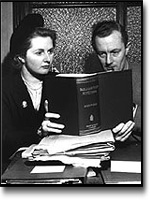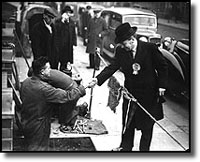
|
23 February 1950The reforming zeal of Clement Attlee's Labour Government had transformed Britain since its election in 1945, but by 1950 the administration was begining to look tired. The performance of the economy drained away support from the Government and Attlee was only returned by a slender majority. With another election just around the corner, Winston Churchill's Conservatives believed just "one more push" would give them power.
Background
Although wartime rationing had started to be phased out from 1948 onwards, some restrictions, unpopular with the voters, were still in place as the election approached. In 1949 Attlee suffered two political rebuffs. The pound had to be devalued and the Government was further embarrassed by the costly failure of the groundnuts scheme, designed to breath life into the British and colonial economies. The Conservative Party, shocked by its defeat in the previous election spent its years in opposition re-organising and preparing to re-take power. Churchill spent the intervening years avoiding the hurly burly of partisan politics and concentrated instead on making grand speeches on defence and foreign policy. This contrasted with the intensely partisan statements made by some Labour politicians, including a remark by Nye Bevan, the Labour Minister for Health who, in 1948, said the Tories were "lower than vermin". As the election approached, Attlee and his Cabinet ruled out the nationalisation of iron and steel until after the nation had voted. By then it was already clear that nationalisation would be at the heart of the upcoming election battle and even some members of the Labour Government had begun to lose their stomach for increased state control over the economy. Attlee did not have to go to the polls till June 1950, but his Chancellor, Sir Stafford Cripps, refused to submit another budget to the House before a general election. Accordingly Attlee set the date set for 23 February 1950.
However critical the Tories were of Labour's nationalisation policies they left the welfare state alone. The Conservative manifesto, This is the Road , accepted the implementation of the welfare state but criticised the Government's reliance on bureaucracy and the over regulation of the economy. Labour went to the polls offering more of the same. Their manifesto, Let us win through together , proposed the nationalisation of the sugar and cement industries. Industrialists reacted fiercely to these new expansions of state control. Tate and Lyle, the sugar manufacturers, launched a particularly effective campaign against the Government. Labour's electioneering was generally lacklustre. Attlee himself paid little attention to public relations and claimed to read newspapers for crosswords rather than news. As the campaign began, the Prime Minister set off on a 1,000 mile election tour of Britain by car, with his wife at the wheel. The Conservatives were, by contrast, highly organised. Rab Butler, former President of the Board of Education, revitalised the grass roots of the party and turned it once more into an effective fighting force. As the nation prepared to vote, Labour had closed the Conservatives' lead in the opinion polls. The Tories were 11 points ahead in October 1949, but now both parties were running neck and neck.
Result
The turnout of 84% was the largest in British history. The Labour Party polled more votes than ever before - despite this the Labour majority was slashed from its record number of 193 in 1945 to just five.
The Tories enjoyed a swing from Labour of 3.3% and won 298 seats.
The future Prime Minister, Edward Heath, was among the additions to the Conservative total.
The Liberal share of the vote continued its decline. Over 300 Liberal candidates lost their deposits and the party as a whole only managed to hold nine seats.
The 1950 election was fought under slightly different conditions than the 1945 campaign. In 1949 The Representation of the People Act was passed ending the representation of the Universities in Parliament and 17 new seats were created.
Attlee and his colleagues decided to soldier on despite what seemed a precarious majority, but the question remained: how long could they stay in power? With the Labour Government having a slender majority and having polled only 46% of the vote, another election before the end of the new Parliament looked certain.
|
Diana, Princess of Wales, 1961-1997
Conference 97
Devolution
The Archive
News |
Issues |
Background |
Parties |
Analysis |
TV/Radio/Web
Interactive |
Forum |
Live |
About This Site
News |
Issues |
Background |
Parties |
Analysis |
TV/Radio/Web
Interactive |
Forum |
Live |
About This Site
© BBC 1997 |
politics97@bbc.co.uk |

